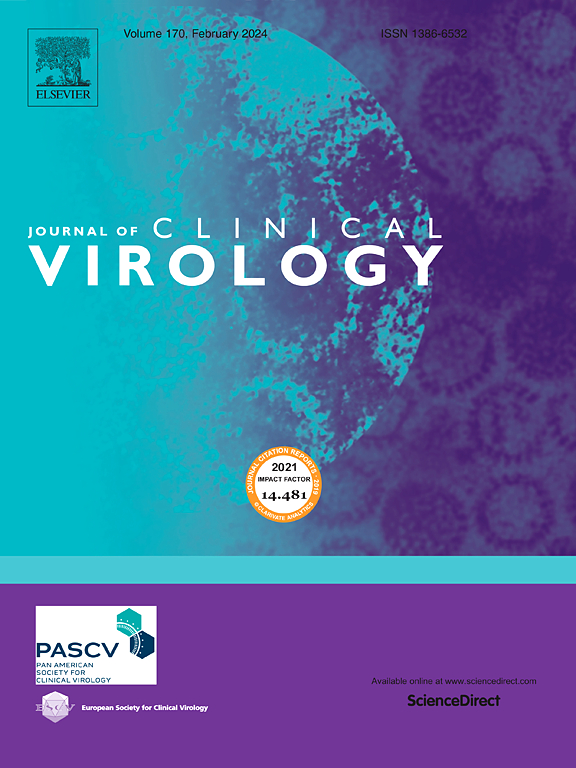More aggressive initiation of antiviral treatment contributes to blocking mother-to-child transmission of HBV DNA & RNA in neonatal umbilical cord blood
IF 3.4
3区 医学
Q2 VIROLOGY
引用次数: 0
Abstract
Background and aims
This study aimed to evaluate the efficacy of expanding antiviral indications in preventing mother-to-child transmission (MTCT) by analyzing hepatitis B virus (HBV) markers in neonatal umbilical-cord-blood (UCB) samples.
Methods
We conducted a real-world study of pregnant women aged >30 years with chronic hepatitis B (CHB) who received antenatal care between January 2022 and June 2024. Maternal HBV markers at 24–28 weeks of gestation and serum biochemical parameters at delivery were obtained. For infants, HBV markers were measured in UCB at birth and in venous blood at 7–12 months of age. Logistic regression analysis was used to identify the maternal factors associated with UCB outcomes.
Results
A total of 171 pregnant women with CHB were included. Antiviral therapy had been started before conception in 31.0 % (53/171). At 24–28 weeks of gestation, 87.8 % (150/171) had HBV DNA <5.3 Log10 IU/mL, 56.1 % (96/171) had hepatitis B surface antigen (HBsAg) >3000 IU/mL and 32.7 % (56/171) were hepatitis B e antigen (HBeAg)-positive. At delivery, HBeAg-negative mothers had a median age of 33.4 ± 3.1 years, compared with 32.5 ± 2.9 years for those who were HBeAg-positive, respectively (t = 1.667, P = 0.970). 36 of 171 (21.1 %) infants were positive for HBsAg, including 12 of 115 born to HBeAg-negative mothers and 24 of 56 born to HBeAg-positive mothers (χ2 = 23.82, P < 0.001). 41 of 171 (24.0 %) infants were positive for HBeAg, and all were born to HBeAg-positive mothers. HBV DNA and RNA were undetectable in all UCB samples, whereas hepatitis B core antibody (HBcAb) was present in every specimen. Receiver operating characteristic curve (ROC) analysis identified maternal HBeAg levels (AUC=0.683, cut-off value=0.494 COI) and maternal HBV DNA load (AUC=0.645, cut-off value=0.311 Log10 IU/mL) as predictive of UCB HBsAg-positivity. No infants were infected with HBV, as confirmed by post-vaccination serologic testing (PVST).
Conclusions
Following the expansion of antiviral therapy indications, administering therapy to pregnant women aged >30 years with detectable HBV DNA effectively reduced HBsAg, HBV DNA and even HBV RNA level in infants’ UCB. Maternal HBeAg status was significantly associated with both HBsAg and HBeAg positivity in UCB.
更积极的抗病毒治疗有助于阻断新生儿脐带血中HBV DNA和RNA的母婴传播
背景与目的本研究旨在通过分析新生儿脐带血(UCB)样本中的乙型肝炎病毒(HBV)标志物,评价扩大抗病毒适应症在预防母婴传播(MTCT)中的疗效。方法:我们对2022年1月至2024年6月期间接受产前护理的30岁慢性乙型肝炎(CHB)孕妇进行了一项现实世界研究。测定产妇妊娠24 ~ 28周时HBV标志物及分娩时血清生化指标。对于婴儿,出生时在UCB和7-12个月时在静脉血中测量HBV标志物。采用Logistic回归分析确定与UCB结局相关的母体因素。结果共纳入171例CHB孕妇。怀孕前开始抗病毒治疗的占31.0% %(53/171)。妊娠24-28周,87.8 % (150/171)HBV DNA检出5.3 Log10 IU/mL, 56.1% %(96/171)乙肝表面抗原(HBsAg)检出3000 IU/mL, 32.7% %(56/171)乙肝e抗原(HBeAg)检出阳性。分娩时,hbeag阴性母亲的中位年龄为33.4 ± 3.1岁,而hbeag阳性母亲的中位年龄为32.5 ± 2.9岁(t = 1.667,P = 0.970)。171例婴儿中有36例(21.1% %)HBsAg阳性,其中hbeag阴性母亲115例中有12例,hbeag阳性母亲56例中有24例(χ2 = 23.82,P <; 0.001)。171例婴儿中有41例(24.0 %)HBeAg阳性,所有婴儿的母亲均为HBeAg阳性。在所有UCB样本中均检测不到HBV DNA和RNA,而在每个样本中均存在乙型肝炎核心抗体(HBcAb)。受试者工作特征曲线(ROC)分析发现,母体HBeAg水平(AUC=0.683,临界值=0.494 COI)和母体HBV DNA负荷(AUC=0.645,临界值=0.311 Log10 IU/mL)可作为UCB hbsag阳性的预测指标。通过疫苗接种后血清学检测(PVST)证实,没有婴儿感染HBV。结论随着抗病毒治疗适应症的扩大,对30岁且HBV DNA可检测的孕妇进行抗病毒治疗可有效降低婴儿UCB中HBsAg、HBV DNA甚至HBV RNA水平。母亲HBeAg水平与UCB中HBsAg和HBeAg阳性均显著相关。
本文章由计算机程序翻译,如有差异,请以英文原文为准。
求助全文
约1分钟内获得全文
求助全文
来源期刊

Journal of Clinical Virology
医学-病毒学
CiteScore
22.70
自引率
1.10%
发文量
149
审稿时长
24 days
期刊介绍:
The Journal of Clinical Virology, an esteemed international publication, serves as the official journal for both the Pan American Society for Clinical Virology and The European Society for Clinical Virology. Dedicated to advancing the understanding of human virology in clinical settings, the Journal of Clinical Virology focuses on disseminating research papers and reviews pertaining to the clinical aspects of virology. Its scope encompasses articles discussing diagnostic methodologies and virus-induced clinical conditions, with an emphasis on practicality and relevance to clinical practice.
The journal publishes on topics that include:
• new diagnostic technologies
• nucleic acid amplification and serologic testing
• targeted and metagenomic next-generation sequencing
• emerging pandemic viral threats
• respiratory viruses
• transplant viruses
• chronic viral infections
• cancer-associated viruses
• gastrointestinal viruses
• central nervous system viruses
• one health (excludes animal health)
 求助内容:
求助内容: 应助结果提醒方式:
应助结果提醒方式:


